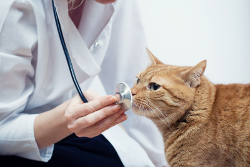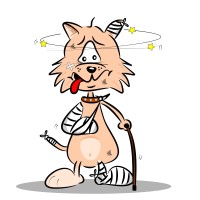In our last post we looked at Thyroid Problems in Cats. Today Arthritis takes the stage. As your feline ages, a certain degree of joint stiffness is to be expected. It is estimated that approximately three out of ten cats age 12 and above suffer from some form of arthritis. If you notice that your cat is having difficulty with normal everyday movement, it could be that your little friend has arthritis. There are many different types of cat arthritis, and only your vet will be able to determine if/what type your cat may have.
Types of Cat Arthritis
- Bacterial Arthritis-this type of cat arthritis is generally caused by a bite wound. Bacteria infects a joint (which can spread other joints in the body) which causes the arthritis. Early detection is imperative since permanent damage can result if left alone.
- Arthritis caused by Calicivirus Infection-most commonly this virus causes respiratory problems, but is also known to cause joint inflammation that can result in lameness. Once treated and cured, most felines recover completely.
- Progressive Polyarthritis-generally only affecting young to middle aged male cats, it affects multiple joints throughout the cats body and is caused by an erosion of the cartilage.
The above conditions do occur often, but the most common type of cat arthritis is osteoarthritis. It occurs in joints that have been unduly stressed, injured, near fractures and dislocations. When the cartilage erodes, new cartilage is made but may be irregular in shape. As your cat ages, over time what was once a smooth surface becomes rough and painful. Obese cats are especially prone to osteoarthritis since it places a much greater strain on the joints. The hip, shoulder, elbow, and ankle are generally the most affected joints, but all joints are susceptible (even the individual joints between the vertebra in the spine).In the majority of cases your vet will need to order blood test as well as x-rays (which usually shows a narrowing of the joint and/or increased bone density near the joint) to determine which type of arthritis is the culprit.
Now that we have discussed several of the different types of cat arthritis that are out there, we should take a look at some of the warning signs to watch out for.
Symptoms
Depending on the severity of the arthritis your feline friend may show no outward signs of any trouble. You may notice little things (after all, no one knows your kitty as well as you do) that can be an indication of problems. Changes in your cat’s behavior and appetite, seeking our places to be alone or warm/soft places to rest, and licking/biting joint areas excessively can be some of the less obvious signs.
While most of the time testing as noted earlier on is required to diagnose arthritis, there are a few common signs to look for:
- Stiffness-less fluid movement than normal, every move seems rigid.
- Limping-favoring a limb and avoiding pressure on it and/or having difficulty arising, especially after sleeping or periods of being still.
- Muscles in the affected limbs may become smaller from lack of use as your cat tries to avoid pain.
- An altered gait-a different set of movements while walking than normal.
- Jumping or climbing stairs appears to be difficult or painful.
None of these symptoms are by any means life threatening, but they can affect your cat’s quality of life. Without treatment, they will normally get worse as time goes on.
Treatment
There is currently no known cure for arthritis, but proper treatment can greatly reduce the problem. Depending on the type and severity of your cats arthritis, the veterinarian could recommend one or a combination of the treatments listed below.
Weight reduction. As noted earlier, excess weight causes undue stress on your cats joints. Light exercise, dietary supplements, and diet cat food may be recommended.
Medications. First of all, never give your animal human over-the-counter medications unless directed by your vet. Some of these can be toxic, even fatal. The most common medications prescribed will relieve pain and inflammation. Omega fatty acids, glucosamine, chondroitin, sulfates, and MSM are the most prevalent.
Making your house arthritis friendly by implementing some or all of these suggestions:
- Keep food and water dishes raised slightly for easy access.
- Use a low rise litter box.
- Seal off cold/damp areas and keep your cat away from them.
- Make his/her favorite place easy to access with stairs or a ramp to prevent jumping.
- Provide a warm place for your cat to sleep with a heated bed or heating pad.
Prevention
Even though arthritis is a normal part of aging, a few simple steps can help prevent or ease the severity. The best step you can take is to maintain a proper weight for your cat. Encouraging and helping your cat exercise can also help avoid/alleviate inflammation. Lastly, as much as is within your power, be cautious and try to avoid injuries.
Genetics do play a huge role in cat arthritis, but with a few simple steps you can drastically reduce the risk or severity for your little one. In our next article we look at Our Top Picks for Fighting Feline parasites.
Thanks for visiting, if you liked this article please like us using the side bar social buttons.



[…] weight can also cause Arthritis and increase the risk of hepatic lipidosis (Feline fatty liver syndrome). Also if your cat were to […]
[…] In our next post we focus on supporting your Feline with Cat Arthritis. […]